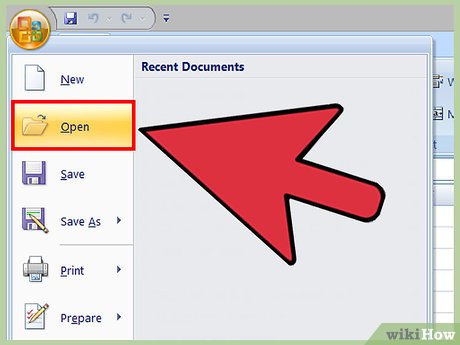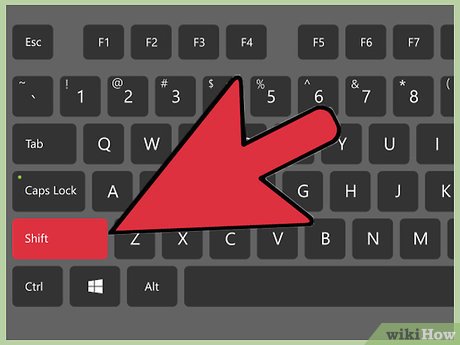How to Find Duplicates in Excel
Method 1 of 2:
Using Conditional Formatting
-
 Open your original file. The first thing you'll need to do is select all data you wish to examine for duplicates.
Open your original file. The first thing you'll need to do is select all data you wish to examine for duplicates. -
 Click the cell in the upper left-hand corner of your data group. This begins the selecting process.
Click the cell in the upper left-hand corner of your data group. This begins the selecting process. -
 Hold down the ⇧ Shift key and click the final cell. Note that the final cell should be in the lower right-hand corner of your data group. This will select all of your data.
Hold down the ⇧ Shift key and click the final cell. Note that the final cell should be in the lower right-hand corner of your data group. This will select all of your data.- You can do this in any order (e.g., click the lower right-hand box first, then highlight from there).
-
 Click on "Conditional Formatting." It can be found in the "Home" tab/ribbon of the toolbar (in many cases, under the "Styles" section).[1] Clicking it will prompt a drop-down menu.
Click on "Conditional Formatting." It can be found in the "Home" tab/ribbon of the toolbar (in many cases, under the "Styles" section).[1] Clicking it will prompt a drop-down menu. -
 Select "Highlight Cells Rules," then "Duplicate Values." Make sure your data is still highlighted when you do this. This will open a window with customization options in another drop-down menu.[2]
Select "Highlight Cells Rules," then "Duplicate Values." Make sure your data is still highlighted when you do this. This will open a window with customization options in another drop-down menu.[2] -
 Select "Duplicate Values" from the drop-down menu.
Select "Duplicate Values" from the drop-down menu.- If you instead wish to display all unique values, you can select "Unique" instead.
-
 Choose your highlight color. The highlight color will designate duplicates. The default is light red with dark red text.[3]
Choose your highlight color. The highlight color will designate duplicates. The default is light red with dark red text.[3] -
 Click "OK" to view your results.
Click "OK" to view your results. -
 Select a duplicate's box and press Delete to delete it. You won't want to delete these values if each piece of data represents something (e.g., a survey).
Select a duplicate's box and press Delete to delete it. You won't want to delete these values if each piece of data represents something (e.g., a survey).- Once you delete a one-time duplicate, its partner value will lose its highlight.
-
 Click on "Conditional Formatting" again. Whether you deleted your duplicates or not, you should remove the highlight formatting before exiting the document.
Click on "Conditional Formatting" again. Whether you deleted your duplicates or not, you should remove the highlight formatting before exiting the document. -
 Select "Clear Rules," then "Clear Rules from Entire Sheet" to clear formatting. This will remove the highlighting around any duplicates you didn't delete.[4]
Select "Clear Rules," then "Clear Rules from Entire Sheet" to clear formatting. This will remove the highlighting around any duplicates you didn't delete.[4]- If you have multiple sections of your spreadsheet formatted, you can select a specific area and click "Clear Rules from Selected Cells" to remove their highlighting.
-
 Save your document's changes. If you're satisfied with your revisions, you have successfully found and deleted duplicates in Excel!
Save your document's changes. If you're satisfied with your revisions, you have successfully found and deleted duplicates in Excel!
Method 2 of 2:
Using Excel's Remove Duplicates Feature
-
 Open your original file. The first thing you'll need to do is select all data you wish to examine for duplicates.
Open your original file. The first thing you'll need to do is select all data you wish to examine for duplicates. -
 Click the cell in the upper left-hand corner of your data group. This begins the selecting process.
Click the cell in the upper left-hand corner of your data group. This begins the selecting process. -
 Hold down the ⇧ Shift key and click the final cell. The final cell is in the lower right-hand corner of your data group. This will select all of your data.
Hold down the ⇧ Shift key and click the final cell. The final cell is in the lower right-hand corner of your data group. This will select all of your data.- You can do this in any order (e.g., click the lower right-hand box first, then highlight from there).
-
 Click on the "Data" tab in the top section of the screen.
Click on the "Data" tab in the top section of the screen. -
 Find the "Data Tools" section of the toolbar. This section includes tools to manipulate your selected data, including the "Remove Duplicates" feature.
Find the "Data Tools" section of the toolbar. This section includes tools to manipulate your selected data, including the "Remove Duplicates" feature. -
 Click "Remove Duplicates." This will bring up a customization window.
Click "Remove Duplicates." This will bring up a customization window. -
 Click "Select All." This will verify all of your columns have been selected.[5]
Click "Select All." This will verify all of your columns have been selected.[5] -
 Check any columns you wish to use this tool on. The default setting has all columns checked.
Check any columns you wish to use this tool on. The default setting has all columns checked. -
 Click the "My data has headers" option, if applicable. This will prompt the program to label the first entry in each column as a header, leaving them out of the deletion process.
Click the "My data has headers" option, if applicable. This will prompt the program to label the first entry in each column as a header, leaving them out of the deletion process. -
 Click "OK" to remove duplicates. When you are satisfied with your options, click "OK". This will automatically remove any duplicate values from your selection.
Click "OK" to remove duplicates. When you are satisfied with your options, click "OK". This will automatically remove any duplicate values from your selection.- If the program tells you that there aren't any duplicates--especially if you know there are--try placing a check next to individual columns in the "Remove Duplicates" window. Scanning each column one at a time will resolve any errors here.
-
 Save your document's changes. If you're satisfied with your revisions, you have successfully deleted duplicates in Excel!
Save your document's changes. If you're satisfied with your revisions, you have successfully deleted duplicates in Excel!
3.5 ★ | 2 Vote























 How to Create a Currency Converter With Microsoft Excel
How to Create a Currency Converter With Microsoft Excel How to Edit a Document on iPhone
How to Edit a Document on iPhone How to Use Box Notes
How to Use Box Notes How to Resize Pictures in Kingsoft Office Writer 2013
How to Resize Pictures in Kingsoft Office Writer 2013 How to Create a Form Using a Word Processor
How to Create a Form Using a Word Processor How to Double Space on WordPad
How to Double Space on WordPad